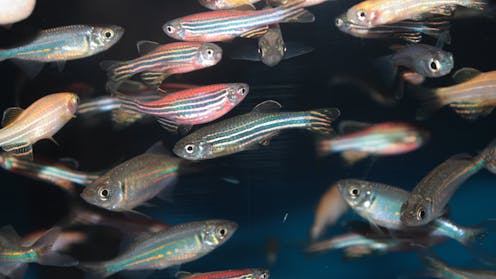Source: The Conversation – in French – By Teresa Rossignoli Palomeque, Personal docente investigador, Universidad Nebrija
Il ne fait plus guère de doute aujourd’hui qu’un usage immodéré et non encadré des écrans a des effets délétères sur le développement des jeunes enfants. Toutefois, les conséquences de l’exposition aux smartphones, tablettes et autres télévisions ne dépendent pas seulement du temps passé devant, mais aussi du contexte d’utilisation et du contenu consulté.
Les écrans occupent désormais une place prépondérante dans nos modes de vie. Ces dernières années, le débat sur les conséquences de l’exposition des tout-petits à leur influence s’est intensifié, tant dans les communautés éducatives et thérapeutiques qu’au sein des familles.
Que sait-on de l’impact réel du temps d’écran sur le développement neuropsychologique des plus jeunes ? Nombre de sociétés savantes et d’associations spécialisées en pédiatrie recommandent de limiter l’usage des écrans durant l’enfance, en particulier chez les moins de 5 ans. Cependant, les recherches révèlent une réalité moins binaire que ce que l’on pourrait imaginer.
En effet, tant le contexte d’utilisation que le contenu consulté conditionnent les effets sur le développement que peut avoir le temps passé devant un écran. Faisons le point.
Des conséquences physiologiques et neuropsychologiques
Une méta-analyse menée récemment a mis en évidence que l’utilisation prolongée d’écrans est associée à de la fatigue oculaire, une sécheresse visuelle et une augmentation du risque de myopie infantile.
En outre, la technologie ne peut ni ne doit se substituer aux jeux, à l’activité physique, au contact avec la nature ou aux interactions avec ses semblables, bref aux stimulations auxquelles sont soumis les enfants au sein de leur environnement.
Des travaux ont montré que remplacer ces expériences par un usage excessif et passif des écrans peut accroître le risque d’obésité, de troubles visuels ou de difficultés d’apprentissage.
Au-delà de ces effets, les inquiétudes concernent aussi les répercussions sur des fonctions telles que l’attention, le langage ou le contrôle émotionnel.

Chaque mardi, le plein d’infos santé : nutrition, bien-être, nouveaux traitements… Abonnez-vous gratuitement dès aujourd’hui.
Une revue de littérature portant sur 102 études menées sur des enfants de moins de 3 ans révèle qu’il importe non seulement de surveiller le temps d’écran, mais surtout la façon dont celui-ci est utilisé, et dans quelles conditions. Ainsi, la présence d’un adulte qui commente ou interagit avec le contenu favorise l’apprentissage et l’attention. En revanche, une exposition passive ou non encadrée constitue un risque pour le développement cognitif de l’enfant.
La simple présence d’un écran en arrière-plan, comme une télévision allumée pendant que l’enfant joue, interfère avec ses activités, son attention et ses interactions avec les autres. Et ce, même si l’enfant ne regarde pas directement l’écran.
En définitive, il ressort de ces observations que tablettes, téléphones et autres télévisions peuvent devenir des outils d’apprentissage, à condition d’être employés dans un but éducatif et sous supervision. Autrement, ils risquent de restreindre les interactions sociales, si indispensables au cerveau en développement.
Le véritable enjeu : l’âge et les contenus inappropriés
On pourrait donc affirmer que le principal risque n’est pas dû à l’écran en tant que tel, mais à ce qu’il diffuse. L’exposition précoce à un contenu inadapté est associée à des difficultés d’attention et à de moins bonnes performances des fonctions exécutives, en particulier en ce qui concerne le contrôle inhibiteur (essentiel à la régulation du comportement et de la cognition), ainsi qu’à des retards de langage.
Certes, les études n’établissent pas de liens de causalité directs avec l’exposition aux écrans. Elles révèlent néanmoins que des niveaux élevés de consommation non sélective de télévision, d’ordinateur, de téléphone ou de tablette chez les très jeunes enfants (3 ans environ) s’accompagnent non seulement d’un moindre contrôle inhibiteur, mais aussi d’une moindre activation cérébrale dans les zones concernées (le cortex préfrontal).
Par ailleurs, regarder la télévision à l’âge de 2 ans exerce un effet négatif sur les fonctions exécutives, effet dont les conséquences se font sentir un an plus tard. Une autre étude, publiée en 2010, a révélé que les enfants qui sont les plus grands consommateurs de télévision sont aussi ceux qui présentent les performances exécutives les plus faibles à l’âge de 4 ans.
La simple consultation passive de plateformes de vidéos telles que YouTube peut elle aussi nuire aux tout-petits. Les enfants de 2 à 3 ans qui y ont été les plus exposés manifestent un moindre développement linguistique, un effet attribué à la réduction de leurs interactions sociales.
D’autres travaux ont établi un lien entre la consommation excessive de télévision et l’existence d’un trouble de l’attention avec hyperactivité à 7 ans, ainsi qu’avec de moindres performances en mathématiques et en vocabulaire. Il a également été observé qu’une exposition trop importante entre 15 mois et 48 mois triple le risque de retard du développement du langage. Ces résultats concordent avec ceux d’autres études menées sur l’exposition des plus jeunes à YouTube.
Une autre perspective : adapter les contenus
Lorsque le contenu est spécifiquement conçu pour les enfants, les conséquences ne sont plus les mêmes. L’exposition à des programmes numériques éducatifs, destinés à améliorer l’attention et les fonctions exécutives chez les 4-6 ans, mène non seulement à des progrès dans ces capacités, mais aussi à une amélioration des performances en matière d’intelligence (mesurée notamment par le Kaufman Brief Intelligence Test, ndlr), d’attention et de mémoire de travail. Il semblerait que des facteurs innés, tels que la présence du gène DAT1, qui code pour le transporteur de la dopamine (un messager chimique qui joue un rôle essentiel dans le mouvement, la motivation, le plaisir et la récompense, ndlr), puissent moduler l’efficacité de ces programmes.
Chez les enfants âgées de 3 ans à 4 ans, regarder du contenu éducatif améliore également le langage (concepts numériques, spatiaux et vocabulaire), surtout lorsque la narration est riche et immersive.
Par ailleurs, la technologie peut soutenir l’inclusion et l’intervention : chez les enfants en situation de vulnérabilité psychosociale de 4 ans à 5 ans, les outils numériques stimulent la mémoire de travail et l’autorégulation. Chez les mineurs autistes (3-16 ans), une intervention digitale améliore l’attention et l’interaction sociale.
Enfin, l’utilisation de vidéos et de médias numériques, dans un contexte d’interactions familiales, a permis d’améliorer le développement linguistique chez des enfants de 2 ans à 4 ans présentant un retard de langage.
Il faut cependant souligner que les preuves d’effets neuropsychologiques positifs sont plus nombreuses à partir de 6 ans. À cet âge, les enfants sont davantage capables de transférer vers leur vie quotidienne les compétences acquises lors des exercices, lesquels touchent à des domaines tels que l’intelligence, la régulation émotionnelle et comportementale, le rendement académique, ou les fonctions exécutives. Les effets constatés vont au-delà des processus entraînés par les outils numériques utilisés.
La solution : technologie, mouvement et interactions sociales ?
Malgré les bénéfices mentionnés précédemment, il faut garder à l’esprit que les écrans ne sauraient remplacer les activités ludiques non dirigées, l’activité physique et les interactions sociales.
Cela étant dit, une récente revue de littérature consacrée à la tranche d’âge 4-12 ans a conclu que la technologie peut jouer un rôle positif lorsqu’elle est utilisée dans le bon contexte, en étant orientée vers des jeux qui engagent l’activité physique et les relations avec les autres.
Il peut s’agir par exemple de recourir à des « objets intelligents », tels qu’un ballon enregistrant les tirs réussis ou une balançoire dotée de capteurs distribuant des récompenses virtuelles, ou de mettre en place des « jeux pervasifs », autrement dit des jeux qui, en recourant à de nouvelles technologies (GPS, réalité augmentée, etc.), créent une expérience ludique combinant des éléments appartenant aux deux mondes, réel et virtuel.
En définitive, la technologie peut constituer un levier pour inciter les enfants à bouger, à explorer et à socialiser, à condition d’être employée dans une perspective pédagogique.
Les recommandations des experts
À la lumière des atouts et des limites des écrans en matière de développement des enfants, voici divers collèges d’experts ont formulé des recommandations.
L’Académie américaine de pédiatrie recommande d’éviter les écrans chez les moins de 18 mois (à l’exception des appels vidéo). Pour les 18-24 mois, seuls les contenus de qualité, toujours consultés en compagnie d’un adulte, sont préconisés. Entre 2 ans et 5 ans, une heure quotidienne d’écrans maximum, et avec des contenus éducatifs. Elle préconise enfin d’éviter les écrans avant le coucher, de les utiliser comme outils pédagogiques – non comme simples distractions – et recommande aux adultes de donner l’exemple, en veillant à avoir eux-mêmes une utilisation saine des technologies numériques.
L’Organisation mondiale de la santé conseille quant à elle de limiter le temps d’écrans à une heure par jour pour les 2-4 ans, et à deux heures par jour pour les 5-17 ans.
(En France, en avril 2025, cinq sociétés savantes – la Société française de pédiatrie, la Société française de santé publique, la Société française de psychiatrie de l’enfant et de l’adolescent, la Société française d’ophtalmologie et la Société francophone de santé et environnement – ont publié une tribune intitulée « Les activités sur écrans ne conviennent pas aux enfants de moins de 6 ans : elles altèrent durablement leurs capacités intellectuelles ». Un an auparavant, la commission de travail sur les écrans rendait son rapport et préconisait de « limiter les écrans et leurs usages en fonction des âges » et souhaitait « guider les adultes vers de bonnes pratiques », avec le mot d’ordre « Pas d’écran avant 3 ans », jugé insuffisant par les organisations signataires du texte de la tribune d’avril 2025, ndlr.)
L’écran n’est pas l’ennemi
Affirmer que les écrans sont « néfastes » par eux-mêmes serait aussi étrange que de considérer que le papier est dangereux, car il peut servir à imprimer n’importe quel type de livres, y compris des ouvrages peu recommandables. Ce qui compte, ce n’est pas le support, mais le contenu, le contexte et la qualité de l’interaction avec le média.
Le défi à relever en ce qui concerne les écrans consiste à trouver l’équilibre, à respecter les étapes de développement des enfants, et à parvenir à faire de la technologie une alliée – non un substitut aux jeux, aux interactions et aux expérimentations dans le monde physique.
![]()
Teresa Rossignoli Palomeque ne travaille pas, ne conseille pas, ne possède pas de parts, ne reçoit pas de fonds d’une organisation qui pourrait tirer profit de cet article, et n’a déclaré aucune autre affiliation que son organisme de recherche.
– ref. Écrans : Comment protéger les enfants de leurs conséquences délétères ? – https://theconversation.com/ecrans-comment-proteger-les-enfants-de-leurs-consequences-deleteres-261128









